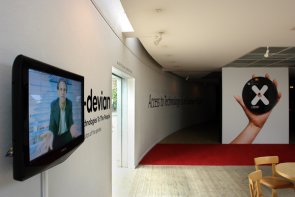

X-Devian. The New Technologies To The People System, 2003
Andújar, Daniel G.
Interactive installation
X-Devian and the Reprogramming of Free Software Culture.
Although the use of free and open source software is becoming more widespread among non-specialist users all over the world, its potential to inform changes in culture outside the computer context is still in the early stages of development. The project X-Devian. The New Technologies to the People System by Daniel Garcia Andujar is one of the most elaborate examples within contemporary art of how that potential could be explored, put into critical and imaginative play. The project revolves around the operating system, X-Devian, a ‘redesigned’ version of a current Linux distribution. Through its multi-level installation format involving videos, objects, website, computer hardware, manuals, imagery, ‘code graffiti’, information, abstraction and fiction, the project presents free and open source software as a cultural discourse, rather than just a technical language. The point being that that discourse needs development, just as much as the software itself. The installation functions as a both conceptual and practical interface to free and open source software encouraging engagement through ideas of culture, specifically a culture where things are done together for a common non-proprietary good. It removes free and open source software from the ghetto of programming code and connects it to a network of assemblages of human reflection, expression and agency. Thereby, X-Devian turns free and open source software into a progressive tool to reprogram the use and understanding of computers as well as social culture at large.

Art historically X-Devian connects to the tradition of conceptual art and its interest in the aesthetics of political discourse, while mixing it with appropriation tactics of pop art and the virtualities of net art to allow for all sort of ironies and complexities. Thus the project eloquently demonstrates that contemporary art’s engagement with issues of technology need not result in computer formalism or fetishism. On the contrary, seen as a radical cultural program technology, and in particular free and open source software, can contribute to the development of contemporary art’s general involvement with issues of social relations and of cultural production run by algorithms of generosity and participation rather than by the omnipresent logics of property. Few artists are able to realise this potential with as much conviction and promise as Daniel Garcia Andujar.
